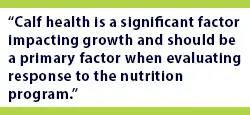
Comparison of growth rates achieved with milk and milk replacers
 By Dr. Noah Litherland, Vita Plus dairy technical services specialist
By Dr. Noah Litherland, Vita Plus dairy technical services specialist
Studying the composition of milk solids intake and calf growth helps us better understand how our feeding program decisions impact efficiency of calf growth. Growth is dependent upon calf health, environment, nutrient intake and composition of nutrients consumed. Energy and protein allowable gain are the nutrients available for growth after energy and protein maintenance requirements have been met. Energy and protein allowable gain are largely provided by milk or milk replacer in the early nursery phase with increasing amounts provided by starter grain as the calf matures through the nursery phase and weaning.
Comparing milk and milk replacers
Rarely has calf growth from milk or milk replacer nutrition been compared within the same study. Compared with a traditional 20/20 formula, modern milk replacers are formulated to match cows’ milk composition more closely.
To compare calf growth and cost of gain across milk replacer and milk feeding approaches, I used the NRC calf growth model to calculate calf growth (starting with a 90-pound calf at a thermoneutral temperature) across milk replacer and milk programs (Table 1). Milk replacers with a 20/20 formula and a 25/25 formula were used in the comparison along with milk with a 27/33 protein/fat concentration. For this example, I set intakes at 1.6 pounds per day of milk solids from day 1 to 42, 0.8 pounds per day from day 43 to 56, and starter only until day 63. Starter intake was held constant for this example at 149 pounds per calf or an average of 2.4 pounds per calf per day.

This exercise shows that:
- Protein intake was lowest for the 20/20 program at 41.3 pounds per calf, intermediate for the 25/25 program at 44.9 pounds and greatest for the milk program at 46.1 pounds per calf.
- Fat intake followed a similar trend to protein intake.
- Calculated metabolizable energy intake from milk followed similar trends for protein and fat intake. However, it is important to note the metabolizable energy intake from milk is 27.4 and 16.5 Mcal per calf greater than the 20/20 and 25/25 milk replacers, respectively.
- Predicted bodyweight at 63 days is greatest for milk-fed calves due to increased protein and energy intake.
- Although the 20/20 program feed costs are lower due to greater predicted rates of gain, the milk program results in the lowest predicted cost of gain.
Consider calf health
 Calf health is a significant factor impacting growth and should be a primary factor when evaluating response to the nutrition program. Milk or milk replacer that is low to moderate in osmolality (influenced by the amount of lactose, sodium and hygiene of the milk) tends to decrease risk of calf gastrointestinal (GI) tract upset and increase efficiency of growth. When the calf’s GI tract is inflamed due to pathogenic bacteria, viruses, or protozoal parasites, or due to nutritional scours the maintenance requirements associated with immune function increase, nutrient digestibility decreases and growth rates tend to decrease.
Calf health is a significant factor impacting growth and should be a primary factor when evaluating response to the nutrition program. Milk or milk replacer that is low to moderate in osmolality (influenced by the amount of lactose, sodium and hygiene of the milk) tends to decrease risk of calf gastrointestinal (GI) tract upset and increase efficiency of growth. When the calf’s GI tract is inflamed due to pathogenic bacteria, viruses, or protozoal parasites, or due to nutritional scours the maintenance requirements associated with immune function increase, nutrient digestibility decreases and growth rates tend to decrease.
Proper ingredient selection, formulation, and mixing result in milk replacer with osmolality that is in the safe and acceptable range, although whole milk will tend to have a lower osmolality than most milk replacers due to lower lactose and ash content. Milk replacer and pasteurized milk with a supplement (such as Calf Magnify) have the advantages of containing additives such as plasma, yeast cell wall (MOS), supplemental organic trace minerals, supplemental vitamins, coccidia control and fly control – all of which offer research-proven benefits.
Take-home messages
- Milk replacer formulas that are closer in composition to cows’ milk (deliver increased amounts of protein and energy) increase calf growth.
- When starter intake is held constant across programs, milk composition has a clear impact on growth.
- Energy intake is an important driver of calf growth. Increased energy intake from milk will increase calf growth as long as starter intake is not decreased.
- Amount of protein and energy consumed from milk and starter drives calf growth.
- Efficiency of gain has a clear impact on cost of gain across milk feeding programs.
| Category: |
Calf and heifer nutrition Starting Strong - Calf Care |

